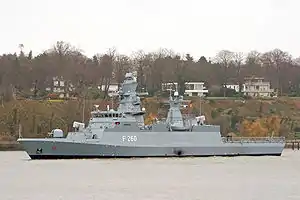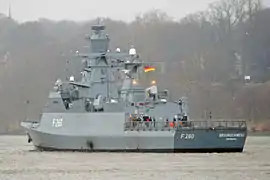German corvette Braunschweig
Braunschweig (F260) is the lead ship of the Braunschweig-class corvette of the German Navy.
 | |
| History | |
|---|---|
| Name: | Braunschweig |
| Namesake: | Braunschweig |
| Port of registry: | Hamburg, Germany |
| Ordered: | December 2001 |
| Builder: | Blohm+Voss, Hamburg |
| Cost: | €240 million |
| Laid down: | 3 December 2004 |
| Launched: | 19 April 2006 |
| Commissioned: | 16 April 2008 |
| Homeport: | Wilhelmshaven, Germany |
| Identification: |
|
| Status: | Active |
| General characteristics | |
| Type: | Braunschweig-class corvette |
| Displacement: | 1,840 tonnes (1,810 long tons) |
| Length: | 89.12 m (292 ft 5 in) |
| Beam: | 13.28 m (43 ft 7 in) |
| Draft: | 3.4 m (11 ft 2 in) |
| Propulsion: | 2 MTU 20V 1163 TB 93 diesel engines producing 14.8MW, driving two controllable-pitch propellers. |
| Speed: | 26 knots (48 km/h; 30 mph) |
| Range: | 4,000 nmi (7,400 km) at 15 kn (28 km/h; 17 mph)[1] |
| Endurance: | 7 days; 21 days with tender[2] |
| Complement: | 65 : 1 commander, 10 officers, 16 chief petty officers, 38 enlisted |
| Sensors and processing systems: | |
| Electronic warfare & decoys: |
|
| Armament: |
|
| Aircraft carried: | Helicopter pad and hangar for two Saab Skeldar |
Developments
The K130 Braunschweig class (sometimes Korvette 130) is Germany's newest class of ocean-going corvettes. Five ships have replaced the Gepard-class fast attack craft of the German Navy.
They feature reduced radar and infrared signatures ("stealth" beyond the Sachsen-class frigates) and will be equipped with two helicopter UAVs for remote sensing. Recently, the German Navy ordered a first batch of two UMS Skeldar V-200 systems for the use on the Braunschweig-class corvettes.[4] The hangar is too small for standard helicopters, but the pad is large enough for Sea Kings, Lynx, or NH-90s, the helicopters of the German Navy.
The German Navy has ordered the RBS-15 Mk4 in advance, which will be a future development of the Mk3 with increased range —400 km (250 mi)— and a dual seeker for increased resistance to electronic countermeasures.[5] The RBS-15 Mk3 has the capability to engage land targets.[6]
In October 2016 it was announced that a second batch of five more frigates is to be procured from 2022–25.[7] The decision was in response to NATO requirements expecting Germany to provide a total of four corvettes at the highest readiness level for littoral operations by 2018, and with only five corvettes just two can be provided.[8]
Construction and career
Braunschweig was laid down on 3 December 2004 and launched on 19 April 2006 in Hamburg. She was commissioned on 16 April 2008.[9]
Braunschweig and KRI Bung Tomo conducted an exercise UNIFIL on 24 June 2017.[10] 19 August 2020, Braunschweig served as a platform for shipborne trials of 2 UMS Skeldar V-200 UAV.[11]
Gallery
References
- "Corvette Braunschweig Handed Over" (Press release). ThyssenKrupp AG. 30 January 2008. Retrieved 14 May 2015.
- "Korvette "Braunschweig"-Klasse (K 130)" (in German). German Navy. Retrieved 7 October 2015.
- "K130 Braunschweig Class Corvette - German Navy". Navyr ecognition. Retrieved 7 October 2015.
- BAAINBw Procures New Helicopter Drones for the Navy, Baainbw, 27 September 2018, retrieved 2 March 2019.
- "de:Neue Aufgaben der Marine mit moderner Ausrüstung" (in German). German Navy. 17 May 2004. Retrieved 14 May 2015.
- German Navy K130 Corvettes Ready for Saab RBS-15 Mk3 Anti-Ship Missiles, Navy recognition, 8 June 2016.
- "Fünf neue Korvetten für die Bundeswehr", Faz.
- "German Navy to Get Five More K130 Braunschweig-class Corvettes", Navy recognition, 14 November 2016.
- "K130 Braunschweig Class Corvette". Naval Technology. Retrieved 2020-09-18.
- "JPNN". www.jpnn.com (in Indonesian). 2017-06-24. Retrieved 2020-09-18.
- www.navyrecognition.com https://www.navyrecognition.com/index.php/news/defence-news/2020/august/8865-german-navy-begins-shipborne-trials-of-ums-skeldar-s-v-200-uav-aboard-k130-corvette.html. Retrieved 2020-09-18. Missing or empty
|title=(help)
Bibliography
- Warship International Staff (2007). "First of the German K 130 Class". Warship International. XLIV (4): 364–365. ISSN 0043-0374.


